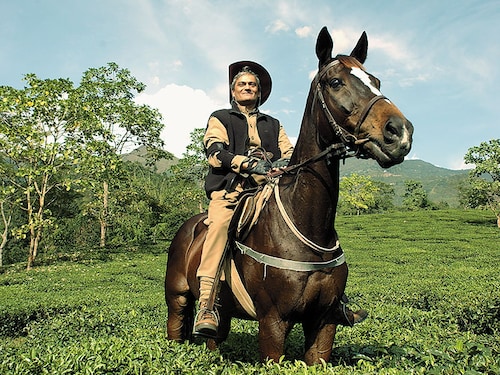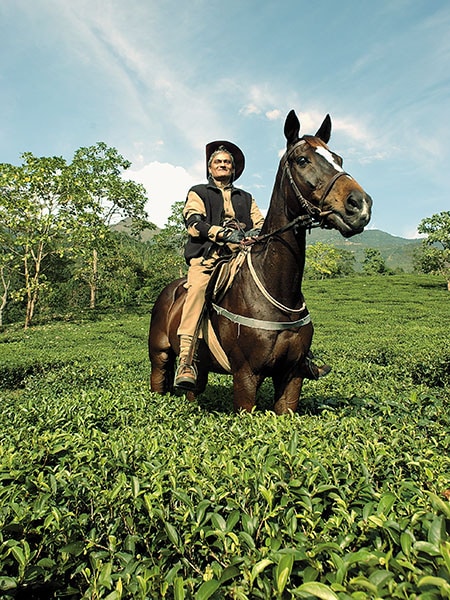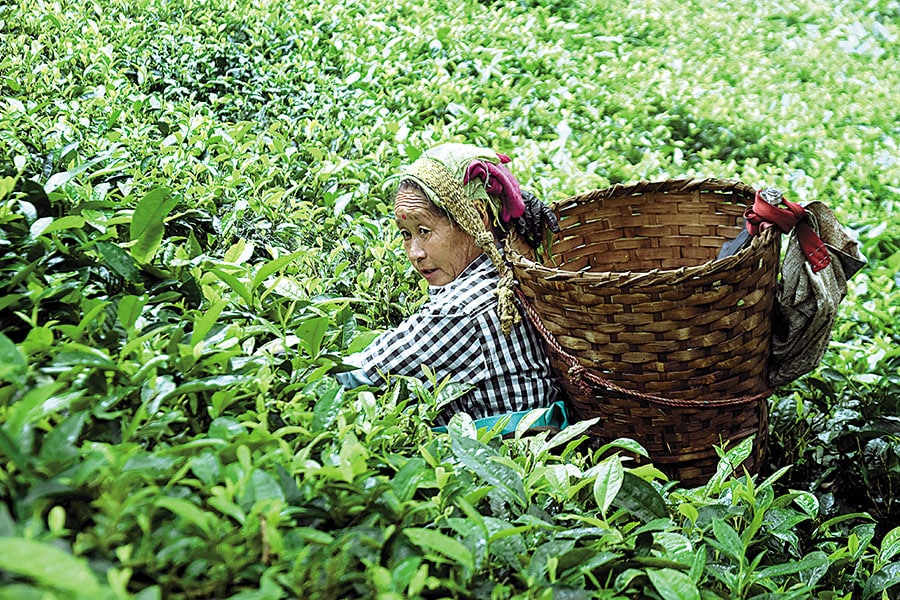Legacy in a tea cup
With Rajah Banerjee moving on from his family tea estate, will the world-famous Makaibari tea lose its magic?



Banerjee, who joined his father’s plantation after resisting for a long time, worked on it for 47 years Image: Courtesy Rajah Banerjee
A chatter rises in the heavy monsoon air, descending the steep slopes of Makaibari. The fog clears, bit by bit, to reveal a group of tea workers in an animated post-lunch conversation. They pause for a breath or two their hands don’t. Their nimble fingers keep working on the tender green leaves—two leaves-and a bud—which, by the same time next day, will be ready to fill the cups of connoisseurs with their exquisite muscatel flavour.
Till some time ago, the women would have an eye trained on the steep flight of steps that Chhota Saheb would have taken to descend from his residence in his sprightly gait.
That was before The Bungalow burnt down.
Now the chor bato (a narrow hill path used as a shortcut) cutting through the rows of tea bushes is covered in moss, barely revealing a skeleton of the narrow concrete steps. It’s been a while since Chhota Saheb last took these steps, or gallivanted from slope to slope on horseback. And, it’s unlikely he ever will.
For, Chhota Saheb, the legendary Rajah Banerjee, has hung up his planter’s boots, and left the estate—home to four generations of his family and the famed Makaibari tea for over 150 years—to make a new beginning with another venture at the age of 70. In mid-October, he launched his new label, Rimpocha, a “reincarnated tea avatar”, which offers a range of single and blended specialty teas.
His departure marks an end of an era at Makaibari, known the world over as the maker of some of the finest, most expensive teas.
*****
If Darjeeling is the champagne of teas,” Time magazine wrote in its April 2008 issue, “Makaibari is the Krug or Henri Giraud.”
The British brought tea to India over 150 years ago, and Makaibari, meaning cornfield in Nepali, was one of the very first gardens. It is the only one in Darjeeling “to never have been owned by the components of the Raj”, its website boasts it almost entirely had only Indian owners—the four generations of Banerjees.
Captain Samler, who deserted the British Army in 1835, began planting it in the mid-19th century, only to bequeath it to his close friend, Girish Chandra Banerjee. A young and enterprising zamindar from Borai in south Bengal, GC set up the world’s first tea factory at Makaibari in 1859.
Rajah Swaraj Kumar Banerjee is GC’s great-grandson under whose stewardship Makaibari became one of the world’s most recognisable tea labels.
“It is like no other Indian brand,” says Rudra Chatterjee, managing director at Luxmi Tea Company, the current owners of Makaibari. “An all-purpose brand reflective of India’s ethos, its inclusive culture… and Rajah Banerjee was a big part of it.”
*****
Siliguri, in the plains of Darjeeling district, is barely 30 km downhill from Makaibari, but is totally different in topography. It is a bustling trade town, bordered by Nepal, Bangladesh and Bhutan.
A cacophony—rickshaw and car horns, temple bells, and the muezzin’s azan—greets me outside Rimpocha House, Banerjee’s current address in Siliguri. This is the first time I am meeting him outside Makaibari, and the first time when he’s not in his trademark work-wear—a full-sleeved shirt with matching riding breeches, work boots and a cowboy hat. Back at the garden, on each day of the week he wore a different colour: White on Mondays, maroon on Tuesdays, green on Wednesdays, yellow on Thursdays, blue on Fridays and black on Saturdays.  Banerjee conducts tea-tasting sessions of his infusions with the skill of a stage performer
Banerjee conducts tea-tasting sessions of his infusions with the skill of a stage performer
Image: Anuradha Sharma
Much relaxed in his civvies, and yet restless with anticipation, Banerjee, now the chairman and managing director of his company T’Classic, is busy trying to sort the logistics of his recently-launched Rimpocha teas. Its 33-odd combinations have flowers, herbs and spices, “ethically sourced” from different parts of India, blended with teas from all over India, mainly Sikkim and Darjeeling. “Except, Makaibari!”
“I did not leave,” Banerjee tells me, over the delicate aroma of the first flush Temi tea at his new office, one floor below his new residence. “Events designed by the cosmos brought me to Makaibari and the same forces designed my exit… I didn’t want to be at Makaibari, and it took me 47 years of experimentation, planting 2 million trees, and creating that primary forest. The fire was an indication that my time was over.”
The fire in March 2017, in a way, ended what had begun on the “momentous” day of August 21, 1970. On that day, thrown off his horse, Banerjee had “perceived a brilliant band of white light connecting me to the trees and forests around me,” he wrote in his book, The Rajah of Darjeeling Organic Tea, Makaibari. The incident, “a miraculous experience beyond time and space”, made Banerjee join his father’s tea plantation, after resisting it for a long time.
His spacious office is nothing like his ancestral office in Makaibari. It boasts no colonial-era wood panels, or mounted trophy hunts, or the nip of the Makaibari mist. Paintings and memorabilia, some of them from his Makaibari office, work hard to add some charm.
Banerjee and I follow up the Temi with Jungpana second flush as our conversation—in English, Nepali and Bengali depending upon context and sentiments—spills into hours.
It is difficult to get a straight answer from Banerjee, who chooses to speak in aphorisms. He loves his one-liners, some trite with overuse. “Miracles are simple solutions.” “Partnership, not ownership is the key.” “The only thing constant is change.” He throws them around with the same dexterity with which he sips, slurps and rolls infusions after infusions on his tongue at tea-tasting sessions, which he conducts for visitors with the skill of a stage performer. “I’m a tree planter, not a tea planter,” he says, repeating one of his favourite lines. “I was never an owner, just a steward in passing.”
*****
When Sheela Tamang arrived at Makaibari as a bride, 27 years ago, she and her husband, the son of estate workers, met the Chhota Saheb. Banerjee congratulated them and gifted them some money. “I was surprised,” says Sheela, now a health worker. “In other gardens, workers hardly get to see the owners, let alone meet them at their residences.”
Unlike other tea estate owners, who mostly live in Kolkata and manage their gardens through on-site managers, Banerjee lived in the garden. This made Makaibari tea what it is. “He was inextricably involved, on a day-to-day basis... he knew everyone’s personal lives,” says Kiran Tawadey, founder of UK-based Hamstead Tea Company, a major importer of Makaibari. Banerjee’s “infectious enthusiasm” helped her found her company in the late 1980s.  Banerjee implemented a variety of projects to improve the condition of workers
Banerjee implemented a variety of projects to improve the condition of workers
Image: Anuradha Sharma
“He would go around riding during our plucking rounds,” reminisces Babita Tamang, generations of whose family have worked at the garden. “Sometimes he would casually chat, or crack a joke. If we were caught plucking coarse leaves by any chance, he’d mock reprimand us.”
The relation between owners and workers on a tea estate is typically that of slave and master, admits Banerjee. At Makaibari, he insists, he tried to change that. Switching from monoculture, which restricted workers to engage only in tea, to permaculture—that involves creating human systems based on natural eco-systems—was one of the measures.
A popular initiative was homestays. “We get about ₹500 a day per tourist, which is a handsome amount,” says Babita. For plucking teas a worker earns about ₹160 a day. “It is a hard life,” says a worker.
Banerjee admits the plantation model of the tea industry is inherently, structurally exploitative, and Makaibari is no exception. Several times he has toyed with the idea of giving workers ownership rights, but he says it is an idea whose time is yet to come. “They were not ready. More than 150 years of dependency cannot be wished away just like that. It takes longer.”
Even at the time of leaving the estate, he announced he would give away his 12 percent share in Makaibari—Luxmi Tea has an 88 percent stake—to the 600 workers, whom he always called partners. But he has now gone back on the proposition. Instead, he is working on putting in place a “welfare trust” to work “for the benefit of the community”.
*****
No one symbolises the romance of Darjeeling tea more than Banerjee, wrote Jeff Koehler in Darjeeling: the Colourful History and Precarious Fate of the World’s Greatest Tea (2015): “He is, by some distance, the most famous man in the business... a galvanising figure and the lone person in the area about whom everyone offers an opinion.”  In 1988, Makaibari became the first Darjeeling tea garden to be organic certified
In 1988, Makaibari became the first Darjeeling tea garden to be organic certified
Image: Anuradha Sharma
Some of Banerjee’s peers dismiss him as gimmicky and ostentatious, but even his harshest critics do not but begrudge him the credit for popularising Darjeeling tea. “He knows how to sell tea to the world. We make the same teas, but he sells better. He has the right skills he tells the best stories,” says a planter.
In 2011, Tokyo’s Royal Blue Tea Company, makers of luxury ready-to-drink teas available in bottles like expensive wines and champagnes, launched a series named after Banerjee—the Royal Darjeeling Rajah—using Makaibari black tea.
“Rajah Banerjee is not just a tea estate owner, but also part of the Makaibari brand,” writes Keiko Yoshimoto, president of Royal Blue Tea Company, in an email. “He implemented biodynamic farming practices, registered Makaibari as a Fairtrade supplier, and implemented a variety of projects to improve conditions of workers. What he has achieved is really fantastic.” She doesn’t think the series will suffer because of Banerjee’s split with Makaibari.
In 1988 Makaibari became the first Darjeeling tea garden to be organic certified, prompting others to join the bandwagon. Today, almost 90 percent of Darjeeling tea gardens are organic, says Banerjee. In 1993, Makaibari also got Fair Trade certification, and became the world’s first tea garden to be certified by Demeter International for its biodynamic practices.
“It was a real pioneering move,” says Tawadey of Hamstead Tea, which paid ₹1.1 lakh for per kg of Makaibari’s Silver Tips Imperial in 2014. “He was extremely passionate,” Tawadey says over phone from the UK. “Even in a bad year, he would strive to achieve the best possible quality.”
Tawadey feels Makaibari has lost its niche with Banerjee’s departure. “Rajah was a very strong, unique selling proposition for Makaibari. It’s not the same. Without him, Makaibari is like any other Darjeeling tea estate, which is a great pity. It will be difficult for the current owners to find a niche [comparable to Banerjee’s].”
*****
Rudra Chatterjee (41), a Columbia Business School graduate and director at the Luxmi Group, ran into “Rajah kaka [uncle]” in 2007. Two years later they decided to develop a ready-to-drink series of Makaibari tea, in collaboration with the late Steve Smith, co-founder of Tazo Tea. But they had to abort the plan following the global economic crisis.
Banerjee’s two sons—settled in Australia and Delhi—had made it clear they would have nothing to do with Makaibari, and he was looking for a succession plan. “I was not getting any younger, and I wanted to leave the community [workers and their dependents] in safe hands,” Banerjee says. “Besides, Makaibari is not just about a garden it’s a much bigger idea.” In Chatterjee, he saw someone who could carry forward his legacy.
undefinedMakaibari, one of the first tea gardens, was the only one in Darjeeling to never have been owned by components of the Raj[/bq]
Chatterjee was “fascinated” by the concept of Makaibari. “It is ethically and socially progressive, an example to follow. It fitted in well with our business ethos.” Luxmi Group is a Kolkata-based company with interests in carpets, real estate, and tea it owns 19 large and small gardens in West Bengal, Assam and Tripura, together producing 20 million kg of tea a year.
In 2014, Luxmi Group acquired a majority stake in Makaibari. “It was a significant investment, a much-needed capital infusion,” says Chatterjee. From 70 percent then, the stake now stands at 88 percent. In spite of the takeover, the two brands—Makaibari and Rajah Banerjee—did not immediately part ways, with the latter continuing as its chairman, overseeing the estate like before.
Then the fire broke out.
The abrupt end to Banerjee’s presence does impact Makaibari. “But this was to happen some day or the other,” says Sanjay Das, the estate manager. “[After the takeover], he had begun grooming me as his successor, teaching me the nitty-gritties of management—the things that made this a unique tea producing land. And, currently, with Rudra Chatterjee at the helm, we are doing every bit to carry forward his legacy.”
Makaibari’s legacy is all set to travel overseas too. “We plan to put to use the lessons we learnt at Makaibari in our upcoming greenfield project, a tea estate over 2,000 hectares in Rwanda,” Chatterjee adds.
*****
Banerjee’s office at Makaibari is now almost bare, but it is still well maintained. “Who knows, Chhota Saheb may return one day,” says an employee.
Meanwhile, having uprooted himself like an old tea bush, Banerjee—“no longer sentinel of ancestral sins” as he calls himself—is adjusting himself to city life. He tells me of his long walks in his neighbourhood in the mornings and marvels on the patches of flora and fauna that a dusty city like Siliguri offers with a child-like enthusiasm.
He still drinks his half a litre of Darjeeling tea in the morning, but not Makaibari anymore.
First Published: Nov 03, 2018, 07:58
Subscribe Now